This post may contain affiliate links. This just means I may receive a small commission at no extra cost to you for helping them promote their product or service. I don’t endorse any services I don’t personally use or recommend.
The soft, unmistakable munching of grazing hippos continued outside our tent. Camping near the Kazinga River, we had fallen asleep to lions calling to one another in the distance. Our evening safari with a local ranger as guide had been a wild success. A couple of full-maned lions, a sneaky leopard, dozens of water-logged hippopotamuses, and seas of gazelle had entertained us for a few hours as we drove through the easternmost region of the park. We had plans to be awake in a few hours, up at first light, to seek out the plentiful herds of elephants known to roam about the Mweya peninsula. Queen Elizabeth was our first national park in East Africa, and it turned out to be one of our favorite parks in the whole region. As self-drivers, we often had to learn the hard way where to go for the best chance of spotting wildlife. This guide will show you how to maximize your time in the park best.
A Quick Look at Queen Elizabeth National Park

As you can see, the massive park sprawls across more than 800 square miles and is divided into three distinct sectors. Inshasha, Mweya, and Kasenyi. If you can, you should visit all three. If you’re short on time…just the latter two. More importantly, the park’s southwestern corner (Inshasha) is separated from the other two sectors by a full day’s drive on dirt roads. This means to visit the park in its entirety; you’ll need at least two days within the park boundaries.
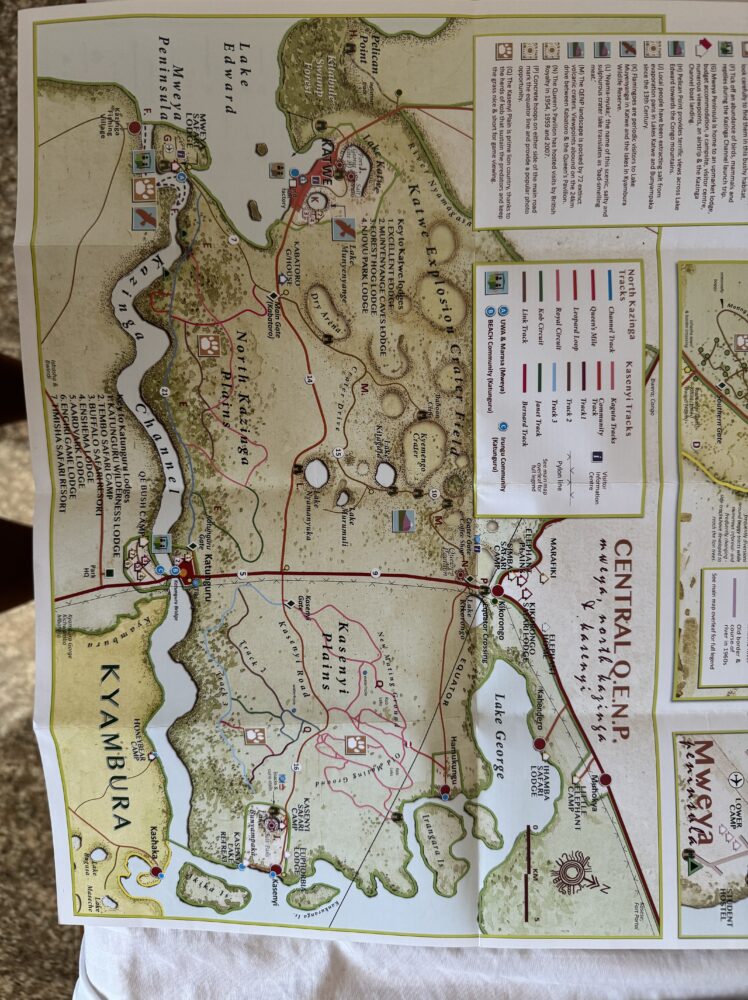

Top Tip: Be sure you are driving a car with Ugandan plates. Foreign-plated vehicles incur an additional $100-$120 fee.
Why Visit Queen Elizabeth National Park
I wrote an entire blog post detailing my favorite national parks in East Africa. Queen Elizabeth is on this list. Not only is it a budget-friendly destination for game drives, night safaris, and boat safaris, but it also allows for some of the best up-close lion encounters we had in Africa. The landscape is fantastic; the lions are known for climbing into cacti and lounging among the thorns, and they are all relatively easy to spot!
If you want to see Elephants or Lions, this is the Ugandan park to choose!
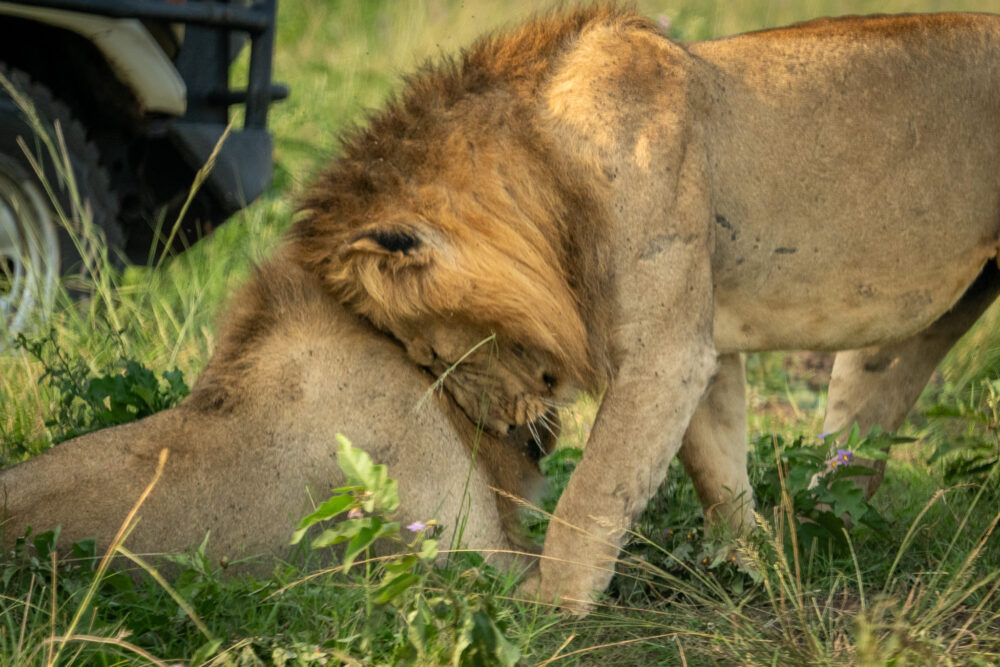

Best Time of Year to Self-Drive in Queen Elizabeth National Park
- May to Mid-September (Dry Season)
The dry season is the only time to drive in Uganda. Thanks to the abundance of clay and dirt roads, it becomes an absolute mess in the rainy months. There is a “short dry season” from December to February in Uganda, but nowadays, it’s really not all that dry. Instead, I recommend visiting in July or August for the driest conditions.
Acquiring Permits for Queen Elizabeth National Park
Your “park ticket” allows you to be in the park for 24 hours EXACTLY and currently costs $40 per person. For the most up-to-date pricing, please see the official Ugandan parks website. This was accurate as of my visit in August 2024.

3 Important Things to Know About Your Park Ticket
1. You must purchase your ticket at the gate with a credit card.
The Ugandan authorities have eliminated cash payments to prevent corrupt rangers from pocketing the money. This helps to ensure it actually goes to the parks—or, at the very least, to the government. However, this can sometimes be a slow process thanks to poor internet connections in remote areas. This is why entering at 10-11 AM is a good idea: You won’t be in a hurry to start a game drive.
2. The time starts ticking the moment you are issued your ticket.
You have 24 hours from this “entry time”. The park rangers will check your permits every time you leave the park, and if you have overstayed, you’ll be required to pay for a full day. Don’t fail to leave yourself enough time to actually exit the gate.

3. When you purchase your park ticket, you’ll probably want to pay for any extras like boat safari, night safari, and park campsites at this time.
Otherwise, you’ll need to return to the main gates to pay for them. It helps to know in advance what you plan to do in the park.
For example, in Queen Elizabeth, I recommend camping in the park and a night safari (if you didn’t do one in Murchison Falls NP).
Security in Queen Elizabeth National Park
According to most government websites, Queen Elizabeth National Park (and the Inshasha Sector specifically) should be avoided. I disagree, but if you care about those things, it is worth knowing. In 2019 and 2023, there were two incidents of terrorism that led to the “do not travel” recommendation. But I think that the risk is low (even for self-drivers), and there have been no incidences since.
Getting to Queen Elizabeth National Park
As a self-driver, there are two routes you could take to reach the park.
If you’ve followed my Uganda itinerary, you will probably enter via the Inshasha sector after visiting Bwindi NP and Buhoma. I recommend this route (even if you don’t spend the night in Inshasha) because it allows for the least amount of backtracking. However, it does require much more rough road driving than the other route, which is nearly completely paved.
The other option (the paved one) runs through Ishaka and Rubirizi and is a good option for those who don’t want to travel through Bwindi National Park or visit Ishasha sector.



5 Things to do in Queen Elizabeth National Park
As a self-driver, the one thing you will definitely do is hit the dirt paths for some wildlife drives. You are on safari, after all. But there are a few activities and extras offered in QENP that you might want to consider. I’ll go over each one-by-one below before I get into my game drive tips.
1. Guided Game Drives.
For $25 (per car), you can pay for a ranger to accompany you on your game drive. They typically know where to find the most elusive animals and can help you navigate the more remote parts of the park. We did one guided game drive in QENP and saw leopards, lions, hippos, elephants, and lots more. The best time for these is in the late afternoon or early morning, and they usually last between 2 and 4 hours.





Top Tip: If you are going to do a guided game drive…do one the evening you arrive. This way, you will know the park’s secrets and can spend the next morning hitting the spots the ranger recommended.
2. Night Safari.
Uganda is the cheapest country in East Africa for a night safari. At $30 per person, it is HIGHLY recommended that you do at least one when in the country if you are interested in nighttime critters like Genet, Bush Babies, Leopards, Spotted Hyena, Jackals, and Lions. The best places are Queen Elizabeth National Park and Murchison Falls National Park.
3. Boat Safari.
A unique experience in East Africa. Found in both Queen Elizabeth National Park and Murchison Falls NP, you can float up the river to spot wildlife up close. These are mainly crocodiles, hippos, elephants, and birds. I think QENP is better for wildlife sightings, but Murchison offers outstanding views of the falls in addition to the wildlife. If I was only to pick one…I would pick Murchison. Expect to pay $30 per person.


4. Visiting Mweya Lodge.
You might think this is a weird little addition because you’re likely to be camping, not staying at a luxury lodge. Still, you can enjoy a real coffee or beer at thier outdoor bar overlooking the Kazinga channel if you’re feeling like a moment of mid-day luxury. Or are you just really, really tired of drinking instant coffee?
5. Drive to the Salt Mine in Kasese
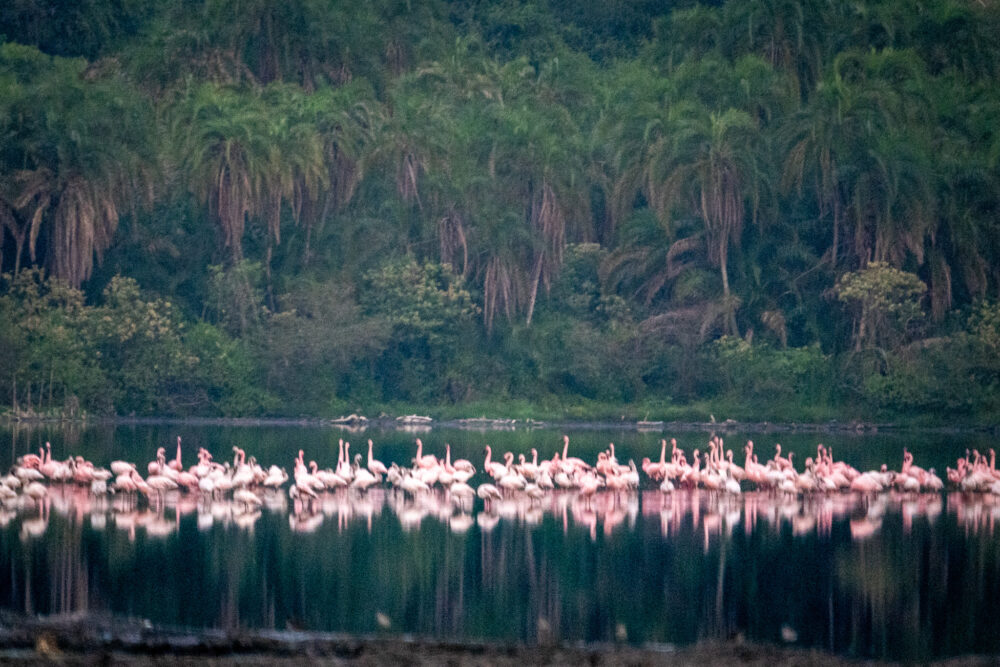
Known for its brightly colored pink salt and flamingo population, I recommend visiting this park area near sunset on one of your game drives. The birds are impressive (if it’s the right time of year), and you can see how some of the local people are making a living within the national park boundaries.
Let’s get into the game drives.
Wildlife You Can Spot in Queen Elizabeth National Park
Here are the most commonly spotted and sought-after wildlife in the national park and where you’ll be most likely to spot them.
- Elephants – Mweya
- Hippo – Mweya
- Lion – Kasenyi
- Leopard – Kisenyi
- Ugandan Kob – Kasenyi
- Warthog – Mweya
- Banded Mongoose – Mweya
- Nile Crocodile – Boat safari
- Waterbuck – Mweya
- Cape Buffalo – Kasenyi

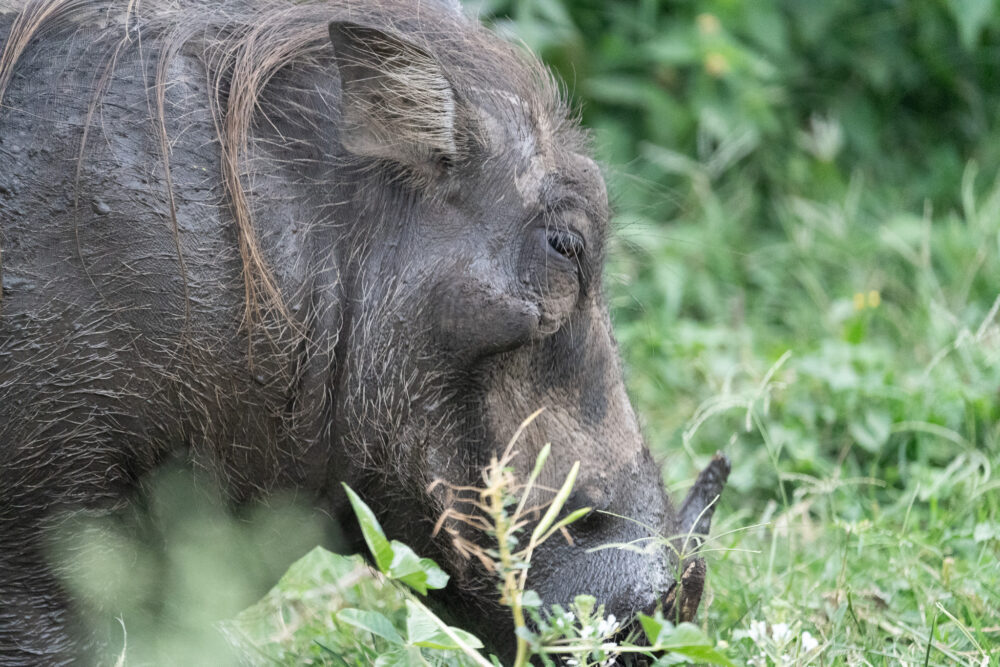
Where to Stay in Queen Elizabeth National Park
While I wholeheartedly recommend camping within Queen Elizabeth National Park, you could also splurge on a once-in-a-lifetime stay with a conservation pioneer like Volcanoes Safaris. The Kyambura Gorge Lodge is just outside the park’s Kisenyi and Mweya sectors. It might be one of the most luxurious places we’ve ever stayed.
Camping Within Queen Elizabeth National Park
If this is your first time camping in Uganda’s national parks, you’re in for a treat. The Mweya Campsite overlooking the Kazinga Channel is rustic but beautiful, and you have an excellent chance of getting some roaming hippos in your camp at night.
Camping in the parks costs $10 per person (affordable for East African parks), and for that fee, you’ll get pit toilets, a fire with extra wood, and a shelter to cook in. You are supposed to get a ranger stationed at your camp to keep away the wildlife…but that did not happen even once for us in Uganda. Honestly, I was more than okay with it, though, as that means we never had to share our campsite.
Top Tip: While you can ground camp in East Africa, I really recommend a rooftop tent for these kinds of excursions. At various points during our time in the region, we had hippos, lions, and elephants in our camp.
If you are also planning to visit Inshasha, I recommend Inshasha NP campsite #1.
Top Tip: IOverlander is the best app for finding and choosing campsites. Be sure to download it before you go.
When to Go on Game Drives In QENP
Wildlife in Uganda is most active in the early morning and late evening. This is pretty much universal for all of Africa. Or any wildlife experience that I have embarked on. This means the best time to drive in the park and spot wildlife is 6-9 AM and 4-7 PM.
I recommend driving in circles as much as you can/want to look for animals. But during the heat of the day, you are most likely to find animals moving to and from the river near the Kazinga Channel or the Channel Drive in Mweya.
Top Tip: You are not supposed to drive within the park before first light and after sunset. This is usually from 7 PM-6 AM.
Where to Go on Game Drives in Queen Elizabeth National Park
Here’s a breakdown of the three sectors and the best places to drive in each.
Kisenyi
This is widely considered the best place to spot the “big ticket” wildlife in the park, specifically leopards and Lions. We spent most of our time focused on this area of the park and had great success.

Mweya
Here, alongside the Channel Drive, you’ll find loads of elephants and hippos, as well as Waterbuck and a stray lion or two. It’s an excellent area for game drives in the early morning on your way to Kisenyi (as you’ll be camping near here) and in mid-day when animals head back from the river.
Top Tip: There is one overpriced gas station in Mweya where you can refuel if need be. Be sure to enter the park TOTALLY full, as you’ll be doing a lot of driving, and you don’t want to run out of gas on the park roads.
Inshasha
Previously, this sector was known for its “tree-climbing lions.” But over the years, thanks to poaching and poisoning by cattle herders, the lions have actually moved to the other two sectors. Inshasha still offers great wildlife watching and does have lions, but of the three, it is the least recommended, in my opinion.
What are the Roads Like in Queen Elizabeth National Park
Dirt. Hopefully. If it has rained a lot before your visit, you are going to have a difficult time in QENP—or in any Ugandan national park, for that matter. That’s why I DO NOT recommend self-driving in the rainy season without much off-roading experience. The roads will be hard-packed and mostly flat.
Be careful not to ever go off-road in the parks. Not only is it illegal, but you’ll also likely run over some Acacia thorns and get a flat tire immediately.
Leopard Loop Closed: When driving in the Mweya region, you’ll run into the ”Leopard Loop,” which runs along the riverside. We started down this track, and it immediately got rutted, steep, and slightly tippy. So, we abandoned it. Later, we learned that it had not yet been serviced since the rainy season and would only have gotten worse as we went along.
Top Tip: Maps.me has a relatively accurate portrayal of the park roads. If you download the Uganda map ahead of time, you should be able to drive yourself relatively easily. Some of the routes are dotted lines, which are technically walking paths, but you will obviously be driving them.
Example Itinerary in Queen Elizabeth National Park
Here is what I would recommend doing during your visit to the park.

2-Day Whole Park Itinerary of QENP
- 10 AM: Enter Inshasha Sector.
- 4 PM: Guided Game Drive of the sector
- Camp at Inshasha Campsite #1
- 5 AM: Early morning game drive to other side of park.
- Noon: Coffee at lodge + mid-day boat safari
- 4 PM: Evening Game Drive in Kisenyi Sector
- Camp at Mweya Campsite
- 6 AM: Channel Drive Game Drive to Kisenyi
- 8 AM: Game drive in Kisenyi Sector.
- 10 AM: Exit Park
I recommend two days in the park. This will make you feel less rushed and allow more time for game drives. If you only have 24 hours, then you can try the itinerary below.
1-Day Kisenyi + Mweya Itinerary
- 10 AM: Enter Park
- 11 AM: Coffee at Mweya Lodge
- 2 PM: Boat Safari
- 4 PM: Guided Game Drive of Kisenyi
- Camp at Mweya Campsite
- 6 AM: Channel Drive to Kisenyi
- 8:30 AM: Kisenyi Game Drive
- 10 AM: Exit Park
Top Tip: You might notice that many signs say the park CLOSES at 7 PM. If you are staying in one of the park lodges or camping within the park, however, you can enter after that time. The gates are manned 24/7, and they will let you enter and drive straight to camp after dark. This “closing time” clarifies that you aren’t supposed to drive around looking for animals alone after dark.
Final Thoughts on Queen Elizabeth National Park
We loved this park. The rangers were helpful, the wildlife sightings were incredible, and the landscape was lush and unique, scattered with candelabra cacti. During our several months in East Africa, it was also the only park where we got to see a leopard for any length of time. Feel free to throw your questions in the comments!
Save This Post For Later!

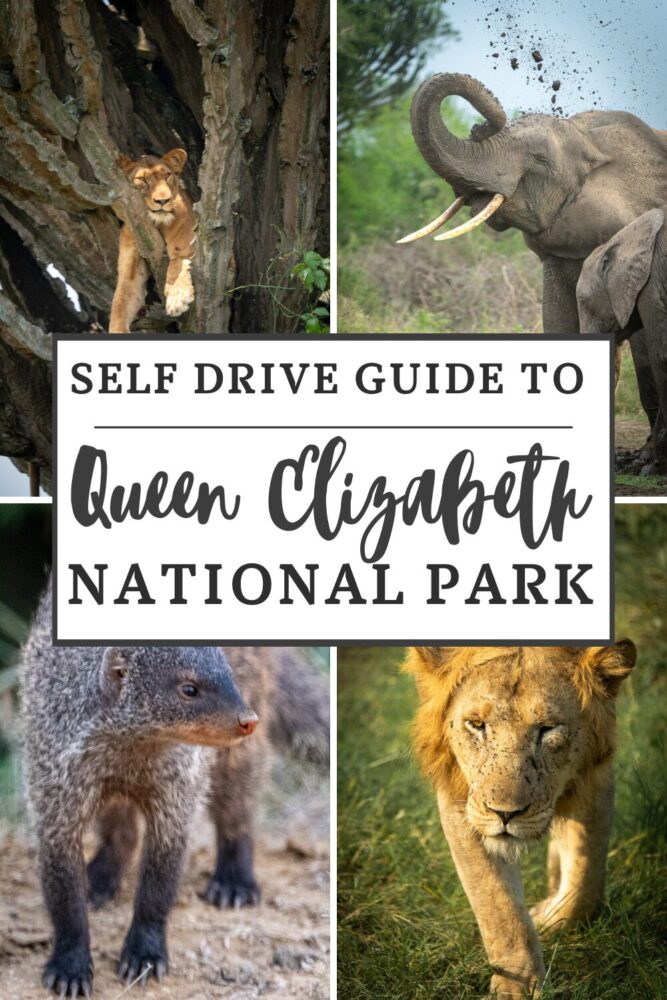





No Comments